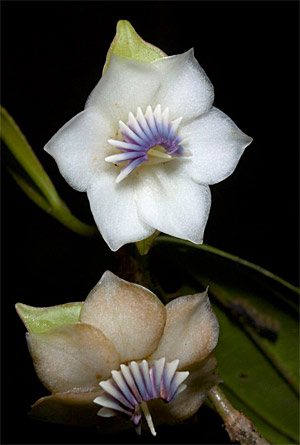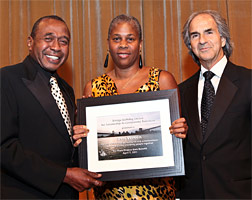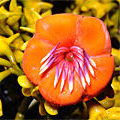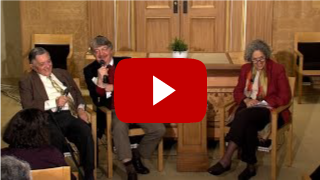
Meriania aurata, a tree species we discovered in what is now EcoMinga’s Rio Zunac Reserve. Flower is large, about 7 cm across. Photo: Lou Jost/EcoMinga
I’m compiling a list of all the plant and animal species discovered by our reserve manager Juan Pablo Reyes, our director Javier Robayo, myself, and our students and co-investigators in and around our EcoMinga reserves near Banos, Ecuador. In this first installment, I’ll deal with the plants. (I’ll be saving some major as-yet-unpublished plant discoveries for a later post.) Nearly all of these species are still known only from our immediate area and nowhere else in the world. Adding these new discoveries to the previously-known locally endemic plants of the area, there are now more plant species unique to this area (the upper Rio Pastaza watershed) than there are in the world-famous Galapagos Islands! This is one reason why we are so committed to its conservation.
I’ll start with two spectacular new species of trees in the melastome family, Meriania aurata and Blakea attenboroughii. Meriania aurata (above) is the most spectacular tree I have ever seen. Imagine big heavy inflorescences half a meter across whose stems look as if they are made of bright shiny yellow plastic, each yellow winged stem carrying an orange rosebud, which becomes a short-lived bright salmon flower 7 cm across with a bizarre row of anthers lined up under the stigma. I first noticed fallen buds of this species here in the Banos area in the 1990s, but that was before I realized just how special the area was. I wrongly assumed that such a dramatic flower must be well-known. By 2001 I understood the area better, and I organized a 15-man expedition to reach new elevations in the Rio Zunac watershed (now part of our Rio Zunac Reserve). David Neill, the renowned Ecuadorian tree expert, came along. We saw this tree; he recognized it as a new species (the sister species of the also-beautiful Meriania hernandoi) and published its description (co-authored by Carmen Ulloa). Even so, we did not find a fresh, fully-opened flower, so the paper does not include a full flower drawing (see below). It was only recently that I finally was able to make these close-up photos of the open flowers (with the help of EcoMinga’s agile tree-climbing guards).

Blakea attenboroughii, from our Naturetrek and Cerro Candelaria Reserves. Photo: Lou Jost/EcoMinga.
The next species, Blakea attenboroughii from the same family (Melastomataceae) was discovered by Javier Robayo, myself, and Andy Orchard of Puro Coffee, donor to the World Land Trust for the first purchases of our Cerro Candelaria Reserve. I am not an expert in this plant group (I’m an orchid taxonomist), but as soon as I saw it I realized it was something I’d never seen before anywhere. Expert Darin Penneys confirmed it was a new species. We decided to name it after World Land Trust patron and famous BBC TV presenter and conservationist Sir David Attenborough, to thank him for his support for our conservation efforts. I had the pleasure of presenting a picture of it to him at a World Land Trust event in the Linnaean Society headquarters in London, where the centuries-old specimens of Linnaeus, the father of modern taxonomy, are carefully kept. Sir David is a wonderful man.











